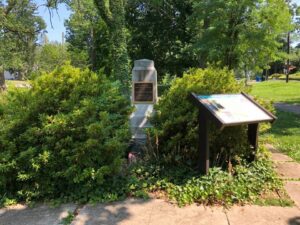Today marks the 157th anniversary of the end of the Battle of Gettysburg, one of the bloodiest battles in US history.
But roughly 35 miles northeast of Gettysburg sits a small stone monument, about six feet tall, that marks the end of the line for the Confederacy. This is the high-water mark of the Confederacy.
The marker denotes the Union line which repulsed a charge by Confederate cavalry on June 30, 1863 in their quest to get to Harrisburg, Pennsylvania, the true target of Lee’s campaign that ended with the Battle of Gettysburg.
Though it is slightly obscured by overgrown shrubbery–the result of budget cutbacks by the local government in the era of Covid–the marker goes largely unnoticed and unrecognized by even the most ardent Civil War buff.

There is no gaudy statue. No bronze sculpture on a pedestal depicting a gallant Union footsoldier clashing with a rebel on horseback. And no flags–Union and Confederate–marking the battle lines. Just a single, short obelisk denoting where the Union held its ground.
Confederate artillery, lined up 400 yards away, mercifully missed the mark, overshooting the Union troops but hitting a nearby church. When the charge came, the New York militia manning the position under the command of Gen. William Smith repulsed the attack. Total casualties: one Confederate rider wounded.
Growing up, I walked by this spot virtually daily on my way to school, having grown up in the house that was occupied by the Confederate commanders during this skirmish. The Confederate artillery line was located in what became our front yard. (The marker was erected after I moved away for college.)
As we prepare to celebrate our nation’s independence, we must honor the people who defended that independence, not those who wanted to destroy it. This virtually-forgotten stone serves as a great metaphor for all nameless patriots who fought to keep our nation and our people free.
(And please forgive me for the personal indulgence.)